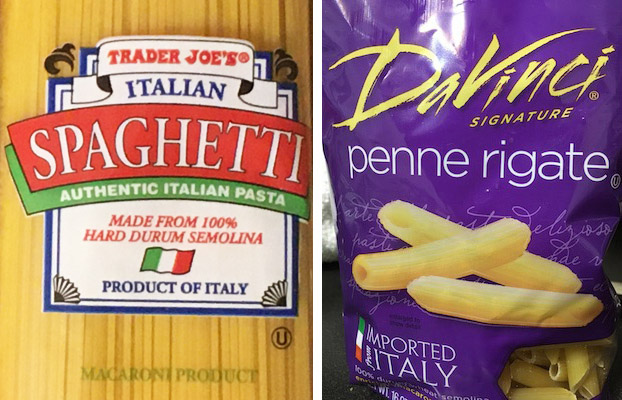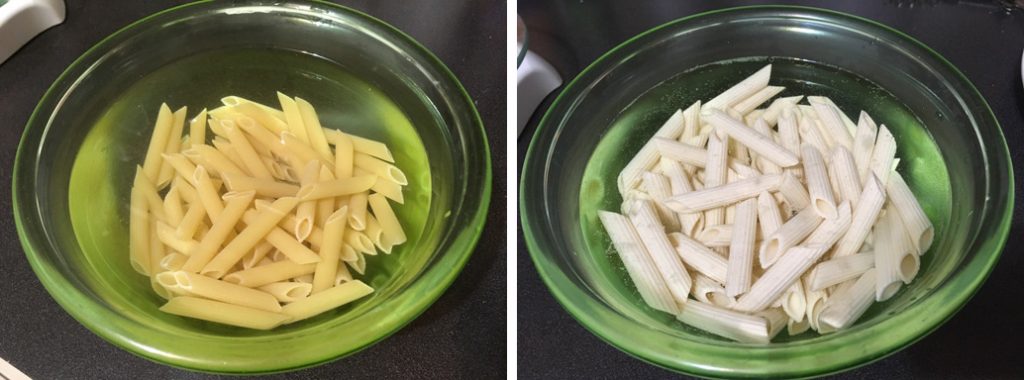I never boil any kind of Italian dry pasta for more than about three minutes.
I’m not talking about Capellini or Vermicelli, and certainly not instant Ramen, all of which are intended to cook in three minutes. I’m talking about big, hearty, chunky Italian pasta, anything from Penne to Manicotti to Lasagne. Only three minutes. You just have to know the trick.
In a world where energy, water, and time are increasingly scarce, this is something people should know.
The package directions on any substantial form of dry Italian pasta, such as Penne Rigate or Rotini or Fusilli, insist that the only way to cook it is to place the dry pasta in a surprisingly large volume of water that has been brought to a full rolling boil, and that boil should continue for ten to fifteen minutes. It seems like a huge waste of energy and attention. And why fill the kitchen with steam?

One day, in 2006, I tried something different. I presoaked my Penne. A few hours later, I checked back — and it had become hydrated, yet still fully retained its shape. I placed it in a downsized volume of boiling water — about 1.5 liters to a four-ounce (dry) serving. It cooked almost instantly. And it was perfect. I never looked back.
Now Penne, Manicotti, Rigatoni, Fusilli, Farfalle, all forms of shells and elbows, and even sheets of Lasagne were on my three-minute menu.
Staying hydrated
Think about it. Pasta is a dried, preserved food. We don’t think twice about rehydrating other dried foods before we cook them. Dry beans, dried mushrooms, dried vegetables, and so on. But oddly, there is no tradition of rehydrating pasta.
Others discovered it a bit later — and probably, others must have quietly known about it before me. I should have spoken up. Looking it up today, it seems that a site called Ideas in Food seems to have broken the news in a more effective manner than I could have, in about 2014. When I researched it in 2007, knowing that it worked exceptionally well, I only found a few comments on various food blogs from others who sheepishly asked if it might work — answered by skeptical, condescending replies, generally saying it wouldn’t work, or if it did, it wasn’t worth the trouble, or it wouldn’t save much energy.
But I tried it. And it does work. And it cuts boiling time from fifteen minutes to two or three, so it does save energy.
Pick the right pasta
It works with all of the standard brands of pasta that I buy. This includes Trader Joe’s standard line of pasta, as well as Barilla, DaVinci, and most other low- to mid-range brands I’ve tried. Typically, any good, hard, durum semolina pasta with a yellow color will stand up to presoaking perfectly.
However, be warned — unlike their standard, cheap variety, I have found that Trader Joe’s organic line of pastas tend to disappointingly go limp and fall into a mass after presoaking. A few other off-brands I’ve occasionally tried have done so as well. The standard, mid-range varieties found in most groceries have always done well for me. Experiment with your own favorite brand. You might be pleasantly surprised.
Here’s how it’s done. Place the dry pasta in a bowl or other container. Then fill it with water. In a few hours, or overnight, it will have rehydrated, turning a creamy white color, as seen below.

If you’ve chosen the right brand of pasta, each piece retains its shape very well even after the water is drained. There is no danger of it turning into mush. I regularly soak Trader Joe’s pasta overnight and have even let it go 24 hours with no trouble.

So now you have something akin to fresh pasta, which is quite expensive and found only in the refrigerated section of better grocery stores.
Three minutes away
You still have to cook it. Bring the water to a boil, drain the soaked pasta and then drop it in gradually. Almost instantly, the creamy white will turn to a darker, translucent shade, indicating that the starch has gelatinized and the pasta is now edible.
Below, you can see that the pieces near the top of the image, which I threw in about ten seconds later than the pieces at the bottom, are still white. The pieces at the bottom are only ten seconds ahead of them, and they are ready to eat. They are a bit al dente, for my taste, but some prefer that. I prefer to let them boil for two to three minutes more, if only because I usually throw in a few vegetables, and they need to cook too.

No going back
On some occasions, I have found myself wanting to cook pasta without having presoaked any. I strongly resist, and usually turn to some other food instead. But on very rare occasions, I must, and so I stand by the boiling pot for ten to fifteen minutes. But I get nothing for my patience. I find that I prefer the texture of presoaked pasta after three minutes of cooking, and the results are more consistent.
The only drawback, other than the need to presoak, is that presoaking enriched pasta may act to leach out some of the vitamin additives that have been added to it. This is certainly happening, because the water often takes on a slight yellow tinge — the characteristic color of riboflavin. But this seems no worse than eating organic pasta, which typically has no added vitamins at all. It’s your choice.
And by the way, you don’t need to salt the water, or add oil, either. But I’ll save these myths for another day.



One Comment
Pingback: